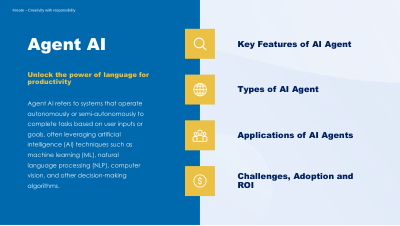agent-ai-slides-main
The Rise of Agent AI: Autonomy, Intelligence, and Transformation🚀 Agent AI: Executive SummaryAgent AI represents the next phase in the AI evolution: autonomous, goal-driven systems that can perceive their environment, make decisions, and complete complex tasks with minimal human supervision. These agents combine autonomy, learning, and goal-oriented behavior to function like digital team members. They can coordinate workflows, adapt to feedback, and continuously improve their performance over time. Agent architectures span reactive, deliberative, and hybrid models. Deployed at scale, they enable far more than simple task automation: they personalize experiences, unlock insights from unstructured data, and drive decision-making in real time. 🖼️ Slides: Visual Overview of Agent AI ConceptsThe following slide thumbnails provide a visual overview of the core ideas behind Agent AI: 



💡 What Is an AI Agent?An AI agent is more than a single model or API call. It is a system that:
Well-designed agents can orchestrate tools, models, and data sources to complete workflows end-to-end — for example, handling a support case, optimizing a schedule, or running a multi-step analysis. Core Features of Agent AIMature Agent AI systems share a common set of capabilities:
Types of AI AgentsDifferent applications call for different agent designs. A common way to categorize them is by how they process information and plan actions:
Transformative Benefits for BusinessWhen deployed thoughtfully, Agent AI systems can transform how organizations operate:
The Road AheadAs models, tools, and infrastructure continue to improve, Agent AI will push the boundaries of what digital automation can do. Instead of scripting every step, organizations will increasingly define goals, constraints, and guardrails — and delegate the execution to agents. The result is a shift from static workflows to adaptive, self-improving systems that behave more like teammates than tools, reshaping how we design products, services, and entire businesses. |
1-intro-agent-to-agent-slides 8-core-principles-for-researc A2a-slides Agent-ai-evolution Agentic-ai-shift-autonomous-s Agentic-ai Ai-agent-suitability-framewor